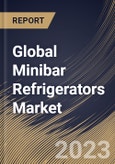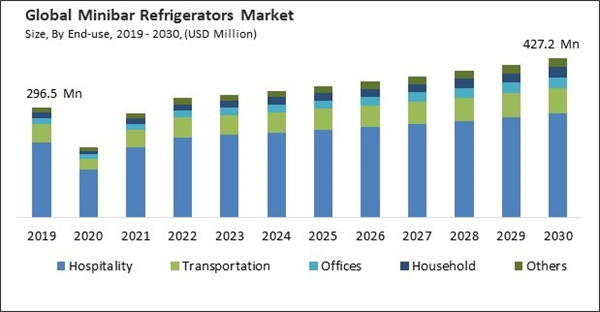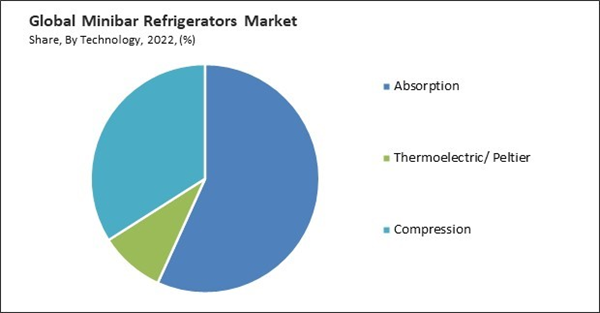The Global Minibar Refrigerators Market size is expected to reach $427.2 million by 2030, rising at a market growth of 3.7% CAGR during the forecast period. In the year 2022, the market attained a volume of 1,964.9 thousand units, experiencing a growth of 4.0% (2019-2022).
Cruise ships often stock minibar refrigerators with complimentary or chargeable beverages, including water, soft drinks, and alcoholic beverages. Consequently, the Cruise ships segment acquired $16,706.4 thousand revenue in the market in 2022. Minibar refrigerators in cruise ship cabins allow passengers to store their beverages, snacks, and personal items in a cool environment. This adds to the comfort of their cabins and enables them to enjoy refreshments at any time without visiting public dining areas. Cruise ships often stock minibar refrigerators with complimentary or chargeable beverages, including water, soft drinks, and alcoholic beverages. Passengers can enjoy these beverages in the privacy of their cabins. Some of the factors impacting the market are growing hospitality industry expansion, rising urbanization and apartment living and high competition of minibar refrigerators.
As the hospitality industry expands, new hotels and accommodations are being built to meet the growing demand from travelers. Many new properties incorporate minibar refrigerators as a standard amenity in guest rooms. This has led to a higher volume of minibar refrigerator installations. Existing hotels and resorts often renovate and upgrade to stay competitive and meet modern traveler expectations. Minibar refrigerators contribute to this by offering guests the convenience of storing and accessing beverages and snacks in the comfort of their rooms, enhancing their overall stay. Apartments in urban areas often have smaller kitchens or kitchenettes compared to suburban or rural homes. Residents may not easily access large grocery stores in densely populated urban areas. Minibar refrigerators enable them to store various foods and beverages, reducing the need for frequent grocery trips. Apartment dwellers often value the independence to prepare and store their meals. The compact size, convenience, and versatility of minibar refrigerators make them popular for urban residents and those living in apartments. As urbanization continues and more people choose apartment living, the market for minibar refrigerators is expected to grow.
However, Intense competition can lead to price wars as manufacturers and retailers try to undercut each other's prices to gain market share. This can result in lower earnings margins for businesses, making investing in research and development or maintaining product quality challenging. In order to stand out in a crowded market, manufacturers must invest in product differentiation through features, design, and technology. This requires ongoing innovation and may entail higher development costs. In mature markets, the market can become saturated, making it difficult for new entrants to gain a foothold. Understanding and predicting consumer behavior in a competitive market is challenging. Changes in consumer preferences, buying patterns, or economic conditions can affect demand unpredictably. These aspects will pose the market growth in the coming years.
The market research report covers the analysis of key stake holders of the market. Key companies profiled in the report include Dometic Group AB, Felix Storch Inc., Minibar Systems, Indel B Group, Hisense International Co., Ltd., Omnitec Systems S.L., Royal Minibars, Tefcold A/S (Lindblad Group ApS), Koolatron Corporation and Bartech Systems international Inc.
Cruise ships often stock minibar refrigerators with complimentary or chargeable beverages, including water, soft drinks, and alcoholic beverages. Consequently, the Cruise ships segment acquired $16,706.4 thousand revenue in the market in 2022. Minibar refrigerators in cruise ship cabins allow passengers to store their beverages, snacks, and personal items in a cool environment. This adds to the comfort of their cabins and enables them to enjoy refreshments at any time without visiting public dining areas. Cruise ships often stock minibar refrigerators with complimentary or chargeable beverages, including water, soft drinks, and alcoholic beverages. Passengers can enjoy these beverages in the privacy of their cabins. Some of the factors impacting the market are growing hospitality industry expansion, rising urbanization and apartment living and high competition of minibar refrigerators.
As the hospitality industry expands, new hotels and accommodations are being built to meet the growing demand from travelers. Many new properties incorporate minibar refrigerators as a standard amenity in guest rooms. This has led to a higher volume of minibar refrigerator installations. Existing hotels and resorts often renovate and upgrade to stay competitive and meet modern traveler expectations. Minibar refrigerators contribute to this by offering guests the convenience of storing and accessing beverages and snacks in the comfort of their rooms, enhancing their overall stay. Apartments in urban areas often have smaller kitchens or kitchenettes compared to suburban or rural homes. Residents may not easily access large grocery stores in densely populated urban areas. Minibar refrigerators enable them to store various foods and beverages, reducing the need for frequent grocery trips. Apartment dwellers often value the independence to prepare and store their meals. The compact size, convenience, and versatility of minibar refrigerators make them popular for urban residents and those living in apartments. As urbanization continues and more people choose apartment living, the market for minibar refrigerators is expected to grow.
However, Intense competition can lead to price wars as manufacturers and retailers try to undercut each other's prices to gain market share. This can result in lower earnings margins for businesses, making investing in research and development or maintaining product quality challenging. In order to stand out in a crowded market, manufacturers must invest in product differentiation through features, design, and technology. This requires ongoing innovation and may entail higher development costs. In mature markets, the market can become saturated, making it difficult for new entrants to gain a foothold. Understanding and predicting consumer behavior in a competitive market is challenging. Changes in consumer preferences, buying patterns, or economic conditions can affect demand unpredictably. These aspects will pose the market growth in the coming years.
Technology Outlook
On the basis of technology, the market is segmented into absorption, thermoelectric/peltier, and compression. In 2022, the absorption segment dominated the market with the maximum revenue share. This can be attributed to factors emphasizing energy efficiency, quiet operation, and technological innovation. Absorption technology, which relies on a heat-driven process to cool the refrigerator rather than a traditional compressor-based system, has gained significant traction due to its unique advantages. One key driver is the growing global emphasis on sustainability and energy conservation. Absorption technology minimizes electricity consumption, making it an attractive choice for eco-conscious consumers and businesses aiming to decrease their energy costs and carbon footprint.End-use Outlook
Based on end-use, the market is fragmented into transportation, hospitality, offices, household, and others. The transportation segment garnered a significant revenue share in the market in 2022. Minibar refrigerators can be integrated into small trucks, vans, or delivery vehicles to transport perishable goods such as food, beverages, pharmaceuticals, or medical specimens. These compact refrigerators are strategically placed within the aircraft's cabin for passengers and flight attendants to quickly access. In some public vehicles, minibar refrigerators may be installed to offer passengers cold drinks and snacks during their journey. This is more common in certain luxury or long-distance bus and train services.Regional Outlook
Region-wise, the market is North America, Europe, Asia Pacific, and LAMEA. In 2022, the Europe region generated the largest revenue share in the market. European consumers increasingly seek devices that offer convenience, energy efficiency, and connectivity features. For instance, in April 2021, Dometic, a Swedish manufacturer of mobile solutions and refrigerators, introduced its HiPro line of minibars. The redesigned minibar improves cooling performance while consuming 40% less power, decreasing operational costs for hotel owners. The modular line offers a range of options: minibars with stainless steel, black mirror glass, or transparent doors; three refrigeration technologies; and a connectivity system with smart remote-controlled features.The market research report covers the analysis of key stake holders of the market. Key companies profiled in the report include Dometic Group AB, Felix Storch Inc., Minibar Systems, Indel B Group, Hisense International Co., Ltd., Omnitec Systems S.L., Royal Minibars, Tefcold A/S (Lindblad Group ApS), Koolatron Corporation and Bartech Systems international Inc.
Scope of the Study
Market Segments Covered in the Report:
By End-use (Volume, Thousand Unit, USD Million, 2019-30)- Hospitality
- Transportation
- Marines
- Cruise Ships
- Campervans/RVs
- Others
- Offices
- Household
- Others
- Absorption
- Thermoelectric/ Peltier
- Compression
- North America
- US
- Canada
- Mexico
- Rest of North America- Europe
- Germany
- UK
- France
- Russia
- Spain
- Italy
- Rest of Europe- Asia Pacific
- China
- Japan
- India
- South Korea
- Singapore
- Malaysia
- Rest of Asia Pacific- LAMEA
- Brazil
- Argentina
- UAE
- Egypt
- South Africa
- Nigeria
- Rest of LAMEA
Key Market Players
List of Companies Profiled in the Report:
- Dometic Group AB
- Felix Storch Inc.
- Minibar Systems
- Indel B Group
- Hisense International Co., Ltd.
- Omnitec Systems S.L.
- Royal Minibars
- Tefcold A/S (Lindblad Group ApS)
- Koolatron Corporation
- Bartech Systems international Inc.
Unique Offerings
- Exhaustive coverage
- The highest number of Market tables and figures
- Subscription-based model available
- Guaranteed best price
- Assured post sales research support with 10% customization free
Table of Contents
Chapter 1. Market Scope & Methodology
Chapter 2. Market at a Glance
Chapter 3. Market Overview
Chapter 4. Global Minibar Refrigerators Market, by End-use
Chapter 5. Global Minibar Refrigerators Market, by Technology
Chapter 6. Global Minibar Refrigerators Market, by Region
Chapter 7. Company Profiles
Companies Mentioned
- Dometic Group AB
- Felix Storch Inc.
- Minibar Systems
- Indel B Group
- Hisense International Co., Ltd.
- Omnitec Systems S.L.
- Royal Minibars
- Tefcold A/S (Lindblad Group ApS)
- Koolatron Corporation
- Bartech Systems international Inc.
Methodology

LOADING...









